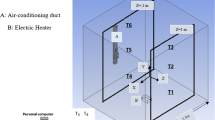Abstract
The air volume of the duct system is important to the performance of the frost-free refrigerator. This paper is focused on the air volume improvement based on the optimization of the duct structure. Firstly, the computational fluid dynamics model of the air duct system in frost-free refrigerator is established, and the grid-independent and validity of the model is investigated according to the experimental data. Secondly, the distribution of velocity, pressure and vortex in fan duct system is studied with the operating conditions, and also the factors of the flow efficiency in duct system are analyzed. Finally, a new air duct system structure is proposed based on the multi-outlet volute and the method of tongue isolation. The results show that the outlet pressure, air volume and air velocity in the new air duct are obviously improved, which means that the new air duct system has a better air supply capability, and it also indicates that the refrigerator has a better cooling effect.

















Similar content being viewed by others
References
Hasanuzzaman M, Saidur R, Masjuki H (2009) Effects of operating variables on heat transfer and energy consumption of a household refrigerator-freezer during closed door operation. Energy 34(2):196–198
Belman-Flores JM, Gallegos-Munoz A (2016) Analysis of the flow and temperature distribution inside the compartment of a small refrigerator. Appl Therm Eng 106(8):743–752
Meng X, Yu B (2009) Experimental research on air flow performance at supply-air openings in frost-free refrigerator by DPIV. Appl Therm Eng 29(16):3334–3339
Li Z, Zhao G, Ding G (2016) Return air duct design for indirect cooling refrigerator based on defrosting optimization. J Refrig 37(1):77–83
Wan B, Zhao D, Ding G (2015) A modular computation method for flow distribution characteristics of air in duct system of indirect cooling refrigerator. J Refrig 36(3):61–65
Liu YH, Wang J, Biao LI (2014) Numerical analysis of air flow field in air-cooled refrigerator with large capacity and its design improvement. Fluid Mach 42(7):69–73
Xiu SU, Chen J, Chen Z (2003) Numerical simulation and optimization of fan area flow field in indirect-cool refrigerator. J Shanghai Jiaotong Univ 37(7):1133–1136
Liu B, Wang Y, Wang Z (2016) Study of the effect of channel inlet size on flow field of fan and performance of heat exchanger. J Hefei Univ Technol 39(12):1602–1607
Yan G, Chen Q, Sun Z (2016) Numerical and experimental study on heat transfer characteristic and thermal load of the freezer gasket in frost-free refrigerators. Int J Refrig 63(6):25–36
Avcı H, Kumlutaş D, Özgün Ö (2016) Optimization of the design parameters of a domestic refrigerator using CFD and artificial neural networks. Int J Refrig 67(7):227–238
Rangavajhala S, Mullur A, Messac A (2008) Investigation of energy consumption and energy savings of refrigerator-freezer during open and closed door condition. J Appl Sci 8(10):1822–1831
Ding L, Wang T, Yang B (2013) Experimental and numerical analysis on the effect of inlet distortion on the performance of a centrifugal fan with a mixing chamber. J Mech Sci Technol 27(2):421–428
Zhang L, Wang S, Chen X (2013) Multi-objective optimization design and experimental investigation of centrifugal fan performance. Chin J Mech Eng 26(6):1267–1276
Acknowledgements
This project was supported by the National Natural Science Foundation of China, Grant Nos. 51106137, 51375444, the Fundamental Research Funds for the Central Universities, Grant No. 2014TS117.
Author information
Authors and Affiliations
Corresponding author
Rights and permissions
About this article
Cite this article
Ye, J., Huang, X., Cheng, Y. et al. Air volume improvement in the duct system in frost-free refrigerators based on the CFD method. J Supercomput 76, 3749–3764 (2020). https://doi.org/10.1007/s11227-018-2586-0
Published:
Issue Date:
DOI: https://doi.org/10.1007/s11227-018-2586-0




